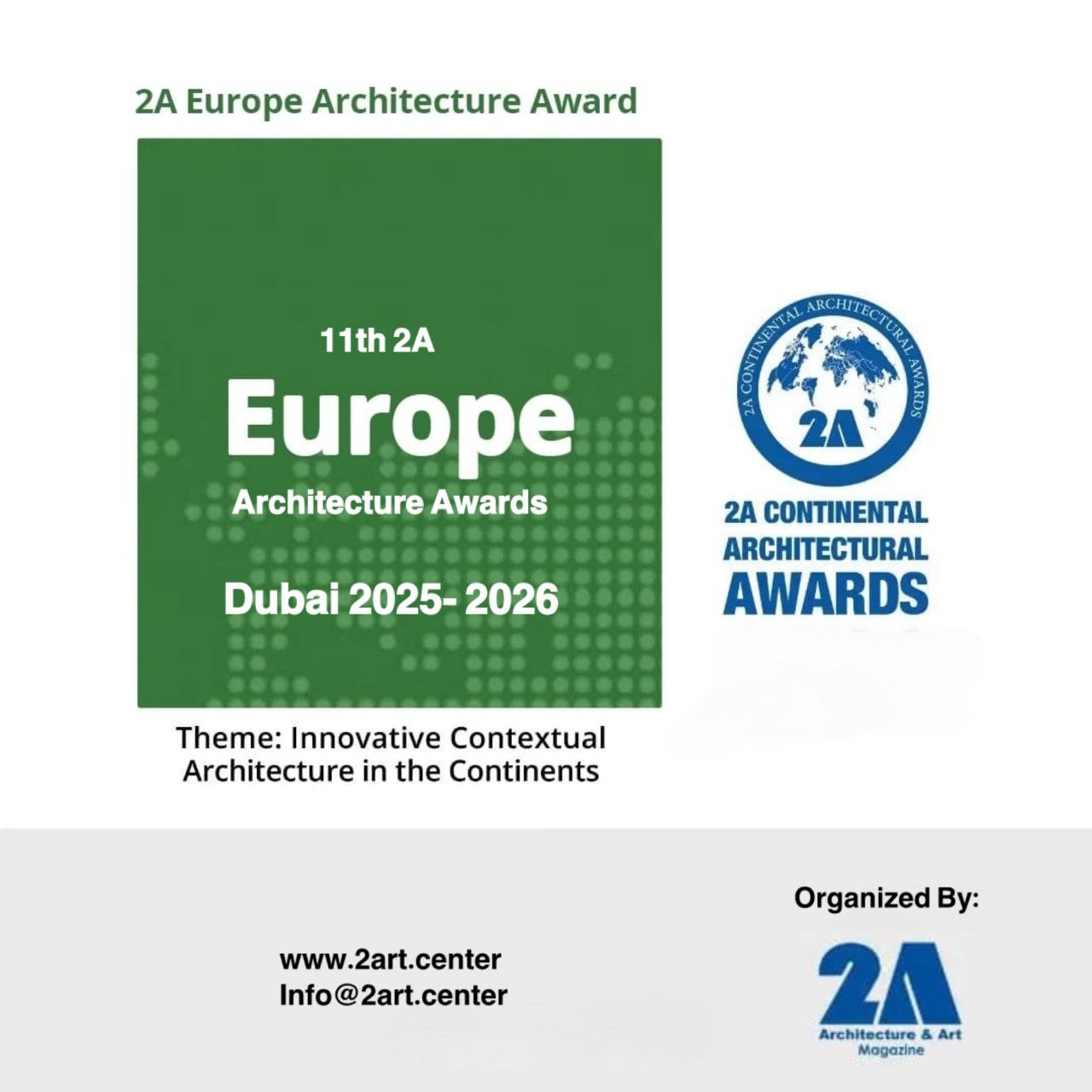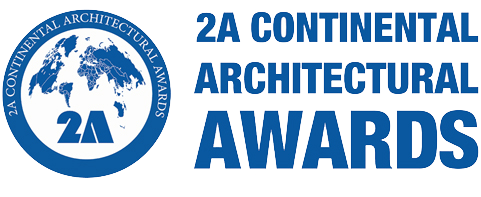
2A EUROPE ARCHITECTURE AWARDS
Theme: Innovative Contextual Architecture Across Continents
Organized by: 2A Magazine
Introduction:
The 11th edition of the 2A Europe Architecture Awards as a part of 2A Continental Architectural Awards continues its mission to recognize and celebrate outstanding achievements in architecture, interior design, and urban design across the continent of Europe.
With the theme of “Innovative Contextual Architecture,” the Awards focus on honoring projects and professionals who have creatively addressed the contemporary challenges of architecture within the cultural, social, and environmental contexts of their regions.
The 2A Europe Architecture Awards’ event highlights global design excellence through:
- Prestigious awards
- Engaging exhibitions
- In-depth debates and discussions on architectural methods and cultural influences
- It brings together architects, urban designers, scholars, and industry leaders to explore diverse perspectives, emerging trends, and innovative design strategies shaped by local identity and global insight.
Vision
Architecture reflects the identity and evolution of a society. Each region’s architectural style is defined by its unique combination of form, materials, construction techniques, and cultural influences. Styles develop over time, shaped by changing beliefs, lifestyles, technologies, and materials. As new ideas emerge, styles adapt—often gradually—and may spread across regions, evolving differently in each context as they respond to local culture and needs.
European Architecture: A Living Dialogue
European architecture, in particular, has been continually transformed by major historical forces—industrialization, wars, migration, and the rise of technology. These changes have created complex challenges for today’s architects, who must balance innovation with cultural continuity. Designing a modern, functional building in Europe today means navigating a landscape of dualities and paradoxes.
Key Challenges in Contemporary European Architecture:
- Diversity and Unity
Architects must reconcile Europe’s cultural diversity with the vision of a unified continent—preserving distinct identities while fostering collective coherence.
- Society and Responsibility
Architecture is more than design—it shapes identity and connects people. Even euro banknotes highlight architecture’s role, depicting bridges and buildings as symbols of unity. This influence carries responsibility across all dimensions: aesthetic, social, environmental, economic, and political. Architecture must respond to societal needs while upholding its integrity and purpose. - Tradition vs. Modernism
The tension between tradition and innovation is a defining element of European architecture. While progress is vital, abandoning historical roots risks cultural amnesia. True advancement respects tradition, using it as a foundation for innovation. Architecture must create a dialogue between past and future, fostering identity while embracing change. - Innovation and Identity
Just as people have identities, so too should buildings. A good building tells a story—it reflects a place, a culture, or a community. It resonates with those who use it and those who see it. Architecture should be both distinctive and relatable, embodying meaning while serving function. Identity in architecture creates dialogue; dialogue, in turn, reinforces identity. - Urbanism
Globalization and urbanization have transformed the human experience. As more people live in cities than ever before, density has become a defining concept. Urbanism now involves complex interactions between people, infrastructure, space, and mobility—requiring thoughtful design to create livable, adaptable, and sustainable environments. - Mobility
In today’s hyperconnected world, mobility defines modern life. Airports, train stations, and transport hubs are architectural feats in their own right—compact, multifunctional spaces that facilitate movement while serving as modern landmarks. Designing these requires balancing efficiency, safety, logistics, and user experience, reflecting the growing complexity of contemporary mobility.
Modern Architecture:
A Break from the Past Modernist architecture, which emerged in the early 20th century, rejected historical styles in favor of new technologies and pure function. Rooted in the belief that architecture should serve contemporary needs, modernism embraced materials like steel and concrete to create bold, efficient designs.
Consequently, 2A Magazine’s vision for the Europe Architecture Awards champions projects that successfully balance tradition and innovation. A truly great European architectural work acknowledges its historical and cultural roots while incorporating modern technologies, materials, and design approaches to meet the demands of the present and future.
Award Significance
The 2A Europe Architecture Awards aims to recognize individuals and teams whose work:
- Offers contextually grounded, innovative solutions to architectural challenges
- Reflects a deep understanding of regional heritage and contemporary needs
- Contributes to the ongoing evolution of architectural theory and practice
- By celebrating architectural responses rooted in specific geographies and cultures, the Awards serve as a platform to promote a more inclusive and multifaceted narrative of global architecture.
- A Platform for Diversity and Dialogue
This event also serves as a professional forum to:
- Showcase the rich diversity of architectural expression across continents
- Foster international collaboration and dialogue
- Encourage cross-disciplinary exploration in architecture and urban design
- Through presentations, debates, and networking opportunities, participants are empowered to share ideas, experiences, and innovations within a collaborative global environment.
Each year, the Awards are framed around a unique theme that addresses current architectural challenges and opportunities. The 2025–2026 edition emphasizes “Innovative Contextual Architecture,” encouraging projects that balance modern design with regional authenticity and environmental consciousness.
This theme reflects the Awards’ broader commitment to honoring architectural excellence that resonates on both local and global scales, influencing the built environment in meaningful and lasting ways.
The Approaches of 2A Europe Architecture Awards 2025-2026 as a part of 2A Continental Architectural Awards (2ACAA)
Architects and urban designers across Asia are increasingly responding to the evolving social, cultural, environmental, and technological challenges of their regions with adaptive, innovative, and contextually rich approaches.
2A Europe Architecture Awards aim to explore and celebrate these dynamic responses by examining the contemporary practice of architecture through multiple lenses, including:
- Cultural, political, economic, and historical narratives
- Theoretical and philosophical approaches
- Artistic and aesthetic expression
- Sustainability and ecological responsibility
- Urban integration and modern technological adaptation
Award’s Criteria:
The 2A Europe Architecture Awards 2025-2026 as a part of 2A Continental Architectural Awards (2ACAA) recognize excellence in both built and future architectural projects that demonstrate a significant contribution to humanity and the built environment.
The evaluation is based on the following key criteria:
- Design Achievement: Conceptual strength, design strategy, and execution
- Contextual Relevance: Interpretation of historical, geographical, and cultural context
- Technical Innovation: Use of materials, structural systems, and engineering solutions
- Sense of Place: Connection to cultural identity, ecological harmony, and sustainability
- Social Responsibility: Community engagement and urban integration
- Economic Considerations: Responsiveness to local economic conditions
- Architectural Depth: Symbolic, philosophical, or transcendental impact
Award Categories
“Completed Projects”
- Commercial: Retail, office, production, and business facilities
- Public Projects: Education, healthcare, hospitality, sports, leisure, and mixed-use buildings
- Residential: Individual and collective housing
- Urban & Rural Design: Public spaces, streetscapes, rural developments, and landscapes
- Old & New: Restoration, regeneration, renovation, and adaptive reuse
- Civic, Religious, & Transport Projects: Places of worship, civic centers, transportation hubs, and community buildings
- Interior Architecture
- Future Projects / Innovative Designs: This category celebrates unbuilt projects and conceptual works, including entries from design competitions. Evaluation focuses on creativity, innovation, context sensitivity, and vision.
Projects must:
- Be located within the eligible continent of Europe
- Address architectural challenges (ecological, cultural, technological, etc.)
- Demonstrate regional insight and research
- Present a unique or forward-thinking design approach
Note: One project cannot be submitted under multiple categories.
New Category: Visionary Architects & Studios
An exclusive category to honor outstanding individuals and design studios. Submissions will be judged based on their portfolio, creative vision, and architectural impact.
Eligibility & Submission Guidelines
- Open to architects, designers, planners, landscape architects, studios, and interdisciplinary teams
- Clients, developers, or contractors may submit entries on behalf of architects with consent
- Built projects must be completed on or after January 1, 2014
- Future projects must be designed no earlier than 2012
Submission Format (Stage One):
- Three A2-size PDF panels per project (Max 16MB each)
- Should include images, drawings, diagrams, and project description
- Stage One submission is free
Entry & Judging Process
- Open Registration: August 1st– September 15th, 2025
- Candidate Selection Notification: Within 48 hours of submission via email
- Official Announcement of Selected Projects: September 28, 2025, on the 2A website
- Judging Format: One-stage entry, two-stage evaluation
- Final Judging & Online Showcase: February 2026 (including video presentation of candidate projects)
- Free Event Pass: Granted to all shortlisted participants
Fees (Upon Selection as Candidate’s Project):
- 1 Project: €189
- 2 Projects: €340
- 3 Projects: €490
Awards & Recognition
- Gold and Silver Medals awarded to the top two projects in each category
- Award Trophies for first-place winners
- Certificates of Recognition for Special Mentions (as determined by the jury)
- Featured Publication: Winning projects will be published in a special edition of 2A Magazine
Organizer Services:
- Professional printing of candidate project panels for jury review
- Display of winning projects in the awards Exhibition
- Complimentary passes to the 2A Awards Ceremony & ArchTalk Forum
- Opportunity to speak at 2A ArchTalk (upon jury selection)
- Honorary Membership in the UNESCO Club of Architecture and Art for top winners
- Video Publication of winners’ professional insights across social platforms
Register Now
Showcase your work on a global stage and join a distinguished community of architects shaping the future of design.
📧 For assistance with submission: info@2art.center
